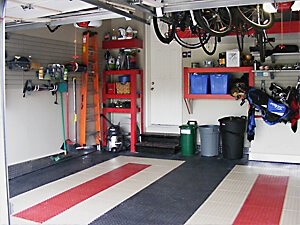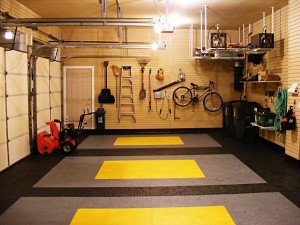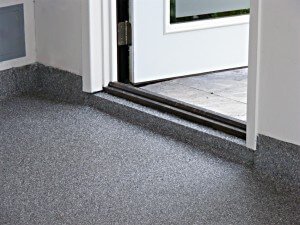We seldom think about the garage floor. However, this important surface undergoes continuous abuse. It must bear the weight of vehicles, withstand damage caused by debris tracked in on tires and shoes and hold its own against leaking automotive fluids. Fluctuating temperatures of sweltering summer heat and frigid Canadian winters cause concrete floors to expand and contract. Then there is the battle of the elements: rain, sleet, snow and salt that gets tracked in on shoes and tires.
Examine your garage floor. Is the surface beginning to show wear? Bare concrete tends to crack, stain or become pitted with age. Cracks and stains not only diminish the beauty of your garage floor, they can compromise the surface, making it vulnerable to degradation. A garage floor coating or covering can preserve the surface and add instant pizzazz. Let’s examine three different garage flooring system options that will enhance the look of your garage and reinforce your floors to better withstand use and harsh weather.
Cover and Protect with PVC Tiles
 There are several factors to consider when selecting the best garage flooring system. Budget and personal preference play a major role. However, the condition of your garage floor is also a consideration. Substantial pitting or cracking requires that voids be filled before coating is applied. Alternately, an interlocking PVC tile floor will hide imperfections and protect floors from further damage.
There are several factors to consider when selecting the best garage flooring system. Budget and personal preference play a major role. However, the condition of your garage floor is also a consideration. Substantial pitting or cracking requires that voids be filled before coating is applied. Alternately, an interlocking PVC tile floor will hide imperfections and protect floors from further damage.
PVC tile offers a less permanent solution. Individual 19 5/8” x 19 5/8” square tiles lock together like puzzle pieces. Available in a range of colors, this modular flooring system can quickly and easily transform the look of your garage while hiding stains and imperfections. Choose tiles in a smooth, matte finish or select a raised medallion surface for additional skid prevention.
 Interlocking PVC tiles are sturdy, attractive and chemical-resistant. They can easily be adapted to fit any garage configuration. Since no adhesive is used, simply remove and replace a single tile in the event of damage. PVC tile can be hosed down, pressure washed, mopped or hand scrubbed.
Interlocking PVC tiles are sturdy, attractive and chemical-resistant. They can easily be adapted to fit any garage configuration. Since no adhesive is used, simply remove and replace a single tile in the event of damage. PVC tile can be hosed down, pressure washed, mopped or hand scrubbed.
The area where drywall meets the floor is susceptible to damage caused by moisture or abuse—like dents from scooters or bicycles. Protect this vulnerable area of the wall by finishing off the look off with six-inch vinyl baseboards. This prevents water damage to the wall and stops water from seeping beneath the tiles, creating mildew.
Seal the Deal with Epoxy Coating
Epoxy is a floor coating that is applied directly to concrete floors. While it is sold in big box stores, consumers run into problems when applying epoxy because they dismiss the importance of surface preparation. More than a simple, weekend DIY project, applying epoxy paint to a garage floor requires several steps in order to achieve the very best results.
 Properly applying epoxy to a concrete floor can require three or four days—during which the garage must remain empty. Major cracks must be repaired to create a smooth finish. Most importantly, the moisture level of the concrete must be checked to determine if a barrier is needed. Skipping this step is the critical mistake most DIYers make. If too much moisture is present, it will seep through the concrete, preventing proper adhesion of the product. When applied under such conditions, the coating begins to flake or chip within a year.
Properly applying epoxy to a concrete floor can require three or four days—during which the garage must remain empty. Major cracks must be repaired to create a smooth finish. Most importantly, the moisture level of the concrete must be checked to determine if a barrier is needed. Skipping this step is the critical mistake most DIYers make. If too much moisture is present, it will seep through the concrete, preventing proper adhesion of the product. When applied under such conditions, the coating begins to flake or chip within a year.
Next, a professional garage floor installation team will use a commercial grinder to remove 1/16th of an inch of the uppermost layer of concrete. This opens the pores of the surface and prepares it to accept the coating. Some may consider bypassing professional installation and using muriatic acid to clean and open the pores of the surface. We do not recommend the use of this hazardous chemical, which isn’t always effective on older concrete surfaces.
Once the surface is properly prepared, a moisture barrier must be applied if the concrete has a high moisture content. After application of the water seal, the epoxy is rolled onto the surface. It must cure before the surface is used.
Epoxy coats the top layer of the surface, sealing it. This stain-resistant coating causes water and oil to bead on the surface, so it can easily be wiped away. Epoxy comes in a wide range of colours and provides some skid resistance. The look is finished with vinyl baseboards in a complementary colour.
Epoxy provides a great, water-resistant coating that can give your garage floor a new look. While it costs much less than polyaspartic coating, application takes at least twice as long. Since the coating sits atop the surface, it is vulnerable to cracking and fading over time due to thermal expansion and contraction of the concrete. However, an epoxy coating application can provide a beautiful, stain-resistant floor for many years.
Polyaspartic Coating—Beautiful, Flexible and Long-lasting
 At Garage Tailors Garage, polyaspartic coating is the preferred garage floor coating. The same preparation steps described above, are required. However, since polyaspartic coating doesn’t take as long to cure, it can be applied in as little as one day. It can also be applied over minor cracks in concrete flooring.
At Garage Tailors Garage, polyaspartic coating is the preferred garage floor coating. The same preparation steps described above, are required. However, since polyaspartic coating doesn’t take as long to cure, it can be applied in as little as one day. It can also be applied over minor cracks in concrete flooring.
Water-soluble polyaspartic coating penetrates the concrete, providing better surface protection than coatings which only coat the top layer. The water-soluble nature of polyaspartic coating makes it fluid, allowing it to shift with the concrete through the expansion and contraction caused by hot and cold temperatures.
Polyaspartic coating is available in an array of attractive colours. A professional garage floor installation team can even create a custom colour for you. To achieve the look, a base coat is applied to the floor. A specified combination of colour flakes is sprinkled over the base coat and allowed to cure. Excess chips and sharp edges are shaved off and vacuumed away before the final sealant is applied. This textured coating looks great and provides excellent skid resistance.
 Standard vinyl baseboards can complete the look. However, polyaspartic coating affords an additional baseboard option that gives a garage a more polished finish. The thicker consistency of polyaspartic coating is ideal for creating a seamless baseboard or wainscoting effect. Plywood is attached to the walls. Then the coating is applied over the wood to create a unified baseboard.
Standard vinyl baseboards can complete the look. However, polyaspartic coating affords an additional baseboard option that gives a garage a more polished finish. The thicker consistency of polyaspartic coating is ideal for creating a seamless baseboard or wainscoting effect. Plywood is attached to the walls. Then the coating is applied over the wood to create a unified baseboard.
Polyaspartic coating is versatile and provides a durable, attractive finish that is guaranteed for the life of your garage floor. To maintain it, simply clean the floor with soap and water or pressure wash it twice a year.
Bare concrete floors generate dust and are susceptible to staining and cracking that gets worse with age. Garage floor coatings and coverings are not only beautiful, but functional. They protect concrete floors from stains and other damage. While garage floor covering or coating is an investment, it can protect floors indefinitely while improving the look and value of your home. Prepare your garage floor to withstand the beating of heavy use and thermal expansion and contraction. Request a consultation to review the available garage flooring systems and see which one is right for you.